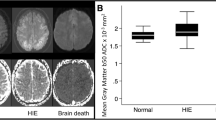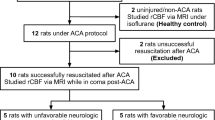Abstract
Background
Glibenclamide (GBC) improves neurological outcome after cardiac arrest (CA) in rats. In this study, we sought to elucidate the mechanism responsible for the neuroprotective effects of GBC by using a high-field MRI system.
Methods
Male Sprague–Dawley rats were subjected to 10-min asphyxial CA followed by cardiopulmonary resuscitation (CPR). Diffusion-weighted imaging (DWI) as well as conventional T2-weighted imaging was conducted prior to CA and at 24, 48, and 72 h after resuscitation. Afterward, histological examination was performed.
Results
Twelve rats were randomized to receive GBC (n = 6) or vehicle (n = 6) at 15 min after return of spontaneous circulation, while four rats were set as sham control. Rats that underwent CA/CPR and received vehicle exhibited distinct neurological deficit, which was alleviated by GBC treatment. Marked water diffusion abnormality as demonstrated by hyperintense DWI in vulnerable regions of the brain was detected after CA/CPR, with the most prominent hyperintense DWI observed in the hippocampal CA1 region at 72 h. Consistently, histological examination revealed neuronal swelling, dendritic injury, and activation of astrocytes and microglia in the hippocampal CA1 region in vehicle-treated rats. Correlation analysis revealed that the ADC values in the hippocampus were significantly correlated with the histological findings (all p < 0.05).
Conclusion
These results suggest that the neuroprotective effects of GBC after CA was exerted, as least in part, through prevention of water diffusion abnormality, namely brain edema.




Similar content being viewed by others
References
Girotra S, van Diepen S, Nallamothu BK, Carrel M, Vellano K, Anderson ML, et al. Regional variation in out-of-hospital cardiac arrest survival in the United States. Circulation. 2016;133:2159–68.
Youn TS, Maciel CB, Greer DM. cerebral edema after cardiac arrest: Tell tale sign of catastrophic injury or a treatable complication? Neurocrit Care. 2016;24:151–2.
Sekhon MS, Ainslie PN, Griesdale DE. Clinical pathophysiology of hypoxic ischemic brain injury after cardiac arrest: a “two-hit” model. Crit Care. 2017;21:90.
Huang K, Gu Y, Hu Y, Ji Z, Wang S, Lin Z, et al. Glibenclamide improves survival and neurologic outcome after cardiac arrest in rats. Crit Care Med. 2015;43:e341–9.
Huang K, Wang Z, Gu Y, Hu Y, Ji Z, Wang S, et al. Glibenclamide is comparable to target temperature management in improving survival and neurological outcome after asphyxial cardiac arrest in rats. J Am Heart Assoc. 2016;5:e3465.
Torbey MT, Selim M, Knorr J, Bigelow C, Recht L. Quantitative analysis of the loss of distinction between gray and white matter in comatose patients after cardiac arrest. Stroke. 2000;31:2163–7.
von Kummer R, Dzialowski I. Imaging of cerebral ischemic edema and neuronal death. Neuroradiology. 2017;59:545–53.
Choi SP, Park KN, Park HK, Kim JY, Youn CS, Ahn KJ, et al. Diffusion-weighted magnetic resonance imaging for predicting the clinical outcome of comatose survivors after cardiac arrest: a cohort study. Crit Care. 2010;14:R17.
Walberer M, Blaes F, Stolz E, Muller C, Schoenburg M, Tschernatsch M, et al. Midline-shift corresponds to the amount of brain edema early after hemispheric stroke–an MRI study in rats. J Neurosurg Anesthesiol. 2007;19:105–10.
Chen L, Fan X, Jin G, Wan X, Qiu R, Yi G, et al. Treatment of rat with traumatic brain injury and MR tracing in vivo via combined transplantation of bone marrow stromal cells labeled with superparamagnetic iron oxide and Schwann cells. J Biomed Nanotechnol. 2014;10:205–15.
Suleymanova EM, Gulyaev MV, Abbasova KR. Structural alterations in the rat brain and behavioral impairment after status epilepticus: an MRI study. Neuroscience. 2016;315:79–90.
Minamishima S, Kida K, Tokuda K, Wang H, Sips PY, Kosugi S, et al. Inhaled nitric oxide improves outcomes after successful cardiopulmonary resuscitation in mice. Circulation. 2011;124:1645–53.
Allegrini PR, Sauer D. Application of magnetic resonance imaging to the measurement of neurodegeneration in rat brain: MRI data correlate strongly with histology and enzymatic analysis. Magn Reson Imaging. 1992;10:773–8.
Yan G, Dai Z, Xuan Y, Wu R. Early metabolic changes following ischemia onset in rats: an in vivo diffusion-weighted imaging and 1H-magnetic resonance spectroscopy study at 7.0 T. Mol Med Rep. 2015;11:4109–14.
Geocadin RG, Ghodadra R, Kimura T, Lei H, Sherman DL, Hanley DF, et al. A novel quantitative EEG injury measure of global cerebral ischemia. Clin Neurophysiol. 2000;111:1779–87.
Hayashida K, Sano M, Kamimura N, Yokota T, Suzuki M, Ohta S, et al. Hydrogen inhalation during normoxic resuscitation improves neurological outcome in a rat model of cardiac arrest, independent of targeted temperature management. Circulation. 2014;130:2173–80.
Wijman CAC, Mlynash M, Finley Caulfield A, Hsia AW, Eyngorn I, Bammer R, et al. Prognostic value of brain diffusion-weighted imaging after cardiac arrest. Ann Neurol. 2009;65:394–402.
Youn CS, Park KN, Kim JY, Callaway CW, Choi SP, Rittenberger JC, et al. Repeated diffusion weighted imaging in comatose cardiac arrest patients with therapeutic hypothermia. Resuscitation. 2015;96:1–8.
Hirsch KG, Mlynash M, Eyngorn I, Pirsaheli R, Okada A, Komshian S, et al. Multi-center study of diffusion-weighted imaging in coma after cardiac arrest. Neurocrit Care. 2015;24:82–9.
Kida K, Minamishima S, Wang H, Ren J, Yigitkanli K, Nozari A, et al. Sodium sulfide prevents water diffusion abnormality in the brain and improves long term outcome after cardiac arrest in mice. Resuscitation. 2012;83:1292–7.
Greer DM, Scripko PD, Wu O, Edlow BL, Bartscher J, Sims JR, et al. Hippocampal magnetic resonance imaging abnormalities in cardiac arrest are associated with poor outcome. J Stroke Cerebrovasc Dis. 2013;22:899–905.
Benveniste H, Hedlund LW, Johnson GA. Mechanism of detection of acute cerebral ischemia in rats by diffusion-weighted magnetic resonance microscopy. Stroke. 1992;23:746–54.
Simard JM, Kent TA, Chen M, Tarasov KV, Gerzanich V. Brain oedema in focal ischemic: molecular pathophysiology and theoretical implications. Lancet Neurol. 2007;6:258–68.
Zhu H, Yoshimoto T, Imajo-Ohmi S, Dazortsava M, Mathivanan A, Yamashima T. Why are hippocampal CA1 neurons vulnerable but motor cortex neurons resistant to transient ischemia? J Neurochem. 2012;120:574–85.
Deshpande J, Bergstedt K, Linden T, Kalimo H, Wieloch T. Ultrastructural changes in the hippocampal CA1 region following transient cerebral ischemia: evidence against programmed cell death. Exp Brain Res. 1992;88:91–105.
Kurland DB, Tosun C, Pampori A, Karimy JK, Caffes NM, Gerzanich V, et al. Glibenclamide for the treatment of acute CNS injury. Pharmaceuticals (Basel). 2013;6:1287–303.
Simard JM, Chen M, Tarasov KV, Bhatta S, Ivanova S, Melnitchenko L, et al. Newly expressed SUR1-regulated NC(Ca-ATP) channel mediates cerebral edema after ischemic stroke. Nat Med. 2006;12:433–40.
Funding
This work is supported by the National Natural Science Foundation of China (Nos. 81701294, 81471339) and the Distinguished Youth Scholar Incubation Program of Nanfang Hospital (2016J005).
Author information
Authors and Affiliations
Corresponding author
Ethics declarations
Conflict of interest
The authors declare that they have no conflict of interest.
Electronic supplementary material
Below is the link to the electronic supplementary material.
Rights and permissions
About this article
Cite this article
Huang, K., Wang, Z., Gu, Y. et al. Glibenclamide Prevents Water Diffusion Abnormality in the Brain After Cardiac Arrest in Rats. Neurocrit Care 29, 128–135 (2018). https://doi.org/10.1007/s12028-018-0505-0
Published:
Issue Date:
DOI: https://doi.org/10.1007/s12028-018-0505-0




